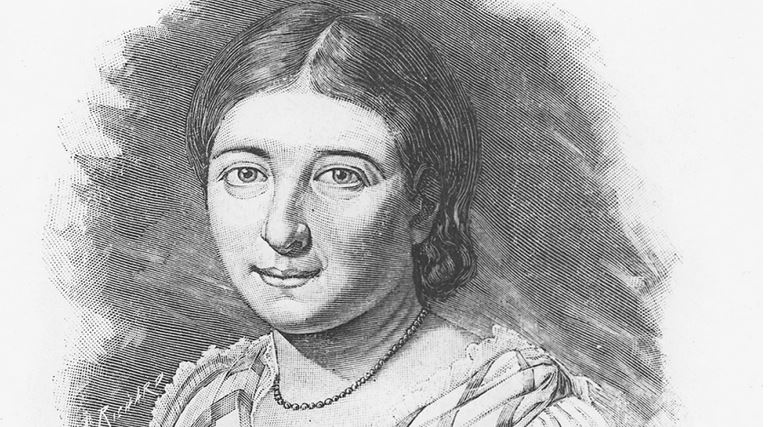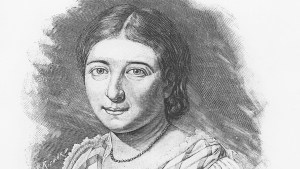
Blessed Pauline Jaricot: A model for turning the light of the Gospel on social issues
She was a 19th-century laywoman who wanted to serve society and the Church from a “cloister of the world.”
As a lay person, Pauline Jaricot is a model “for many Christians who want to live their faith as baptized people without entering religious life,” according to Bishop Georges Colomb, director of the Pontifical Mission Societies (PMS) for France and bishop of La Rochelle and Saintes, in a recent interview with i.Media. He was speaking on the occasion of the upcoming beatification of Venerable Pauline Jaricot, who founded the pontifical office he currently directs.
On May 26, the Holy Father Francis recognized a miracle attributed to the intercession of the Venerable Servant of God Pauline Maria Jaricot, foundress of the Societies of the “Council of the Propagation of the Faith” and of the “Living Rosary.” The date of her beatification has not been set.
Jaricot was born July 22, 1799, in Lyon (France) and died there on January 9, 1862.
What does the beatification of Pauline Jaricot represent for the Pontifical Mission Societies and for the whole Church?
Bishop Colomb: It’s a great joy for the whole Church, of course, but especially for the Pontifical Mission Societies and for the Diocese of Lyon, since Pauline was born in this city and was very much marked by her youth and her family background. This young woman experienced a great turning point during Lent of 1816 when a priest preached on the vanity of young girls. This sermon made her reflect a lot on her own life. Pauline, who was a very coquettish young girl, then discovered that there was more to life than that.
She became interested in her environment and in the challenges of her time. She discovered the importance of social issues, and then became interested in the missions of the Church, thanks to a friend of her brother, a seminarian at the Foreign Missions of Paris. This led to the foundation of the Society of the Propagation of the Faith in 1822. She was only 23 years old. In the wake of this, she founded the Living Rosary society. These initiatives are very concrete works.

How can we describe the personality of this young woman?
Bishop Colomb: Pauline was a young woman with her feet on the ground. She set up the “penny for the missions” initiative, which grew considerably. The Living Rosary grew to reach 2.5 million people a few years before her death. She was also a very intuitive person. The 19th century in which she lived was also that of the Industrial Revolution. Pauline, the daughter of silk workers, was sensitive to the difficult working conditions of the workers. She intervened even during the bloody revolution, as well as in the Canut revolts, by interposing herself between the forces of law and order and the workers.
She tried to get some women out of prostitution by sending them to work at the home of one of her relatives. She also created the Bank of Heaven, an organization offering free loans for workers, aware that the proclamation of the Gospel also finds expression through the recognition of the dignity of the person. She had a missionary spirit that would characterize the 20th century, and at the same time she was a woman of prayer and contemplation. She was truly a daughter of her time, who recognized the challenges that needed to be faced.
In what way can she be a model for Christians today, and especially for young people?
Bishop Colomb: She can be a model for many Christians who want to live their faith as baptized people without entering religious life. She didn’t want to be a religious; instead, she would say, “My cloister is the world.” She didn’t only say this; she lived it, and in this, she’s a model for young and old alike.
Definitely young people can see her as a model, because at 23 years of age she had already done extraordinary things. Valor doesn’t wait to express itself until someone is old; she is an illustration of this. She’s someone who went in all directions and who worked for the mission from home. In this sense, she has something in common with St. Therese, who wanted to be a Carmelite in Vietnam but who became patroness of the missions from her convent. These saints are models for young people because they testify that one can have a beautiful, dignified and full life at the age of 20.
How will the PMS continue to work to make her known?
Bishop Colomb: We’ve been working on this for a long time. There are going to be many celebrations, events, and conferences. Her beatification will be an opportunity to speak about her, but especially about the mission, which has taken a new turn in the 21st century. Today, we’re the ones who welcome missionaries from all continents because our secularized societies need them. It’s a gift for the Church. It takes a lot of humility and wisdom to welcome this gift.